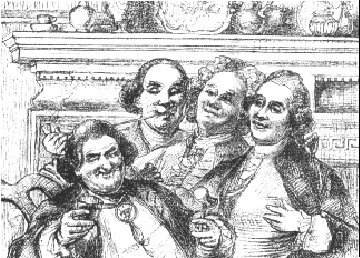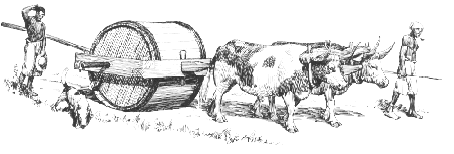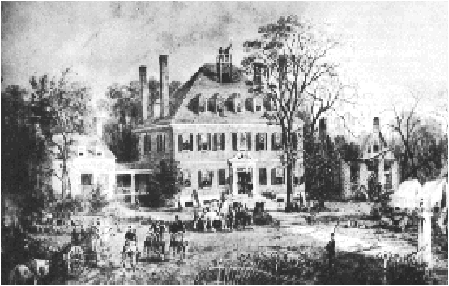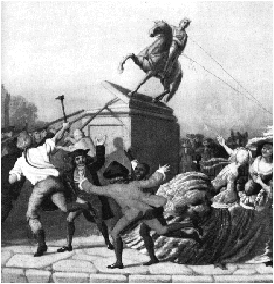|
|
William Broughill, the
immigrant
1714??-1789? |
|
William Broughill first
appears in the first Caroline Court Orders of 1732, when he registered a
slave with the court. No connection has been found between Aaron
Broughill of Essex County and William Broughill of Caroline County, but
circumstances suggest they were somehow related. The northern part of
Essex county became part of Caroline County when it was formed in 1728;
and William Broughill appears in Caroline's first Court Orders of 1732.
On the other hand, Aaron lived in the Southern part of Essex, not the
part incorporated into Caroline, and his name never appears in Caroline
Court Orders.
A spot check of post-1768
Caroline Court Orders revealed that in April of 1789, John Homes, Gent,
having taking oath and entered into bond, was granted a certificate for
obtaining Letters of Administration with the will annex of William
Broughill, deceased. This seems to be contradictory as an administrator
is appointed to settle an estate when a person dies intestate. If there
was a will it was among the destroyed Caroline records, so names of any
heirs have been lost.
The period from 1732 to
1789 spans 57 years, so William must surely have been a young man in
1732. If he was then 18 years old, then he would have been born around
1714. Aaron would then have been 48 years old, making it doubtful that
he was Williams' father. He was the right age to have been his
grandfather. Interestingly, English parish records show that William
Broughill and Ann Hackley were married at Sutton Maddock, Shropshire,
England on Sept. 23, 1712. On May 1, 1714, they christened a son named
William at Sutton Maddock. Could he be the William Broughill who settled
in Caroline County? William, husband of Ann Hackley, may be the William
Brohall, who was christened July 27, 1690 at Cound, Shropshire.
Possibly, Aaron was an uncle. Perhaps he stopped in to visit the
Broughills of Sutton Maddock and spun tales about the wealth of Virginia
that inspired young William to seek his fortune in the colonies.
The 1732 slave
registration may reflect that the younger William had just reached his
age of majority and then registered his property. Between 1732 and 1734,
there were a total of 405 young Negroes, under the age sixteen, so
registered. His slave could have been the young girl Sarah, who
was judged by the Court to be fourteen years old in 1739.
In 1733, William Watford
and William Skelton brought suit against William Broughill and were
awarded 381 pounds of tobacco, which was a rather sizable amount.
The Court Orders do not state the cause of action nor any details. |
 |
The Maryland Club portrays
colonists of William's time. The scene is not unlike those which would
have taken place in Rennold's Tavern. Note the clothing so indicative of
close cultural ties with mother England. |
|
|
Then
there was the incident with tavern keeper Benjamin Rennolds
(Reynolds). Robert Willis was awarded the first license to run an
ordinary (tavern) in Caroline and soon contracted with the court to
furnish the magistrates with small beer. The contract carried a fat
stipend of 1,000 pounds of tobacco, so Rennolds and his buddies
descended on Willis' Tavern and quickly reduced it to shambles.
Apparently he obtained the contract because on one occasion he passed
around so much beer that some of the jury "became drunk and were not
in their good senses." Rennolds was later indicted by the court for
this wanton destruction of the Willis Tavern, but a jury composed
mostly of his friends refused to convict him. In 1734, Rennolds
brought suit against William Broughill and two other people.
Unfortunately the Court Orders do not state the charge, only that the
case was dismissed.
During the 1735 election, Rennolds attempted to
have one of his friends, one Robert Fleming, elected to the post of
magistrate, probably to help him obtain the coveted beer contract, but
this attempt was met by bitter opposition by those who supported his
opponent, Jonathan Gibson. A full record of what happened can be
pieced together from the Journal of the House of Burgesses, which
found:
|
(1) The greater number of votes were cast for Gibson,
(2) the manner of the election was disorderly; people drank too much
liquor on election day, before and during the taking of the polls,
(3) Thomas Roy, a tobacco inspector, threatened scores of voters that if
they did not vote for Gibson he was going to grade their tobacco as of
inferior quality, and if he heard of them electioneering for Martin that
he was going to burn the tobacco they had stored in his warehouse,
(4) William Burdette, a deputy sheriff and tax collector threatened to
foreclose on all taxpayers in arrears in the payment of taxes if he
heard they had voted for Martin,
(5) that during the election Roy and Burdette stood in the polls yelling
threats as each person was called upon to verbally signify his choice of
candidate,
(6) that Gibson's supporters kept jugs of liquors at the polls and
treated voters who supported their candidate both before and after they
cast their ballot, and
(7) that Thomas Harrison and John Davis entered the polls and announced
that they were going to vote for Martin, but before they could do so,
hoodlums snatched them outside, got them so drunk that they were
"not in their good sense", and then brought them back inside
to vote for Gibson. |
|
After his initial involvement with
Watford, Skelton and Turner, William seems to have become a rather
respected member of the community. Englishmen in Virginia were
guaranteed the right to trial by jury, but in practice the local
magistrates "stacked the juries" in favor of the Crown. William served
on jury duty four times during the 1730's suggesting that his verdicts
reflected the wishes of the King's Magistrates. Virginians were
required by law to attend Church and if they missed more than two
consecutive Sundays then they faced legal prosecution, conviction, and
heavy fine and even imprisonment. Court Orders show that William
served on a jury which convicted several people for refusing to attend
the Anglican Church.
These incidents suggest that William evolved
into the model English settler. Not only did his jury decisions reflect
the wishes of the Crown, but on September 9, 1743, he petitioned the
Court to add his name to the Tithing (Tax) Lists. Asking to pay
taxes is an unusual act and it suggests that William may have felt some
extraordinary need to prove his loyalty to the English Crown. |
 |
Rolling a hogshead of tobacco
to a tobacco warehouse.
|
|
During the 1730's and
1740's, Caroline had no towns, nor town-associated occupations.
The entire economy was based on tobacco. Those who grew it were known
as planters and their farms were called plantations. William was
probably a small planter. After harvesting and curing, he prized
(packed) his tobacco into hogsheads, which he rolled down to the Mattaponi River, loaded upon
a flat boat, and floated downstream to a tobacco warehouse for shipment
to England.
There is no record of William receiving a land
grant or patent from the Commonwealth of Virginia. Caroline's Deed Books
have been lost, but occasionally buyers recorded the deed in the Court
Orders. Caroline's Court Orders do not reflect William recording any
such deed. If he owned land, it may have been purchased prior to the
beginning of the records in 1732. If so, then at some later date, it
would probably have been transferred, but no such transfer appears in
the Court Orders. The Court Orders do show that William Broughill leased
land from Benjamin and Elizabeth Powell in 1742 and from John Baylor in
1752. Baylor was one of the county's leading land owners and his
farm was located about three miles south of Caroline's present day court
house at Bowling Green.
A clue as to the location of William's home is
that on Oct. 13, 1757, he was appointed overseer of the road from Grymes'
Quarter to the Douge Towne Bridge and was ordered to keep the same in
good repair. Almost without exception, a road overseer was a person who
lived very near the road he was to oversee. Douge Towne Bridge was
located at approximately where modern day route 301 crosses the
Mattaponi River.
William Broughill Jr. and John Broughill first
appear in Caroline's Court Orders in 1758. Both were then over age 21,
so were born prior to 1737, and thus were almost certainly the sons of
William, who probably married around 1732 or 1733. There may have been
other children, but no mention of them appears in the Court Orders so
far published. It's quite likely they included one or more daughters. If
so, then if they had occasion to appear in court orders, they would have
carried their husband's surname.
William Broughill was executor of the estate of
a Robert Lyon. In 1758, Robert's daughters, Sarah and Ann Lyon,
"being admitted to choose a guardian made choice of William
Broughill". It was then customary for orphans over the age of
sixteen to be given that choice. No doubt Sarah had known him for
many years as William served on juries with Robert Lyon in the 1730's. |
| Although Virginia became famous for the gracious
lifestyle of its plantations, very few were as prosperous as Westover.
Most planters lived in small frame houses. |
 |
|
The 1790 and 1800 Censuses of
Virginia have been lost, believed destroyed when the British burned
Washington during the War of 1812. The 1790 Census has been
somewhat recreated by State Tax Lists. The Caroline Tax List for
1783 lists William Broughill in Caroline County with one tithable white
and five slaves. "Tithes" were essentially a tax based on head
count made on males between the ages of 16 and 65. Since William was too
old to have been tithable (he was then 71), the tithable white must have
been John Broughill. The five slaves indicate a small plantation.
A spot check of later Caroline Court Orders
revealed reference to a 1791 suit "Nunn vs. Broughills." The
plural use of the name establishes that William was survived by more
than one family member. |
|
Betty Branghile |
|
As
Caroline's Church Parish Records have long disappeared, no record has
been found of William's marriage. However, the Will of Edward Goode of
Caroline County was made 28 March 1763, and probated in Williamsburg and
thus escaped destruction. One of the witnesses was Betty Branghile.
Caroline County Records list only one surname even close in appearance
to Branghile and it, of course, is Broughill. Betty may have been
William's wife, his daughter, or daughter-in-law. No further reference
has been found to her. |
William Broughill Jr.
1735??-1808? |
William Broughill Jr. was dragged into the Court Orders on Aug. 11,
1758, when Charles Story brought suit against him for back debts. His
father agreed to be responsible for the debt in the event that William
Jr. lost the case. Interestingly, that same day, Edmond Taylor brought a
suit against Benjamin Lankford in debt and William Sr. also guaranteed
his performance.
William Jr. was living in Caroline County when
his son James was born in April of 1761. He was still in Caroline
on Oct. 12, 1765, when he acknowledged a debt to Colin and William
Dunlop and Company, Plaintiff, as did his brother John. He does not
appear in the Caroline County Court Orders for 1766 and 1767.
By 1771, he was living on the south branch of
Bruck Creek, New Plantation, Pittsylvania County, Virginia, because on
November 9th of that year, he sold 100 acres on Bruck Creek to John
East. The deed was recorded and names his wife as Sarah. No record
has been found as to how this property was obtained. According to Steve
White, a Virginia attorney who often performs title searches, early
settlers often conveyed land through hand written deeds, which often
were not recorded. On March 27, 1772, John East filed suit against
William Broyhill in Halifax County. This case has not been
researched, but may have involved the land that William sold him the
previous year. The resulting court record is the first documented
use of the "Broyhill" spelling.
William Jr. was apparently the father of James
Broughill, but it is not known how many other children he may have
fathered. The only clue lies in the Halifax Tax Lists. The one for 1783
lists James Braughill as head of a household containing 5 whites and 0
blacks. Yet the one for 1785 lists William Broy with 7 whites and 0
blacks. Apparently in 1783, William Jr. was not at the homestead when
the Tax List was taken, so James, being the eldest son, was listed as
the head of household, which probably consisted of James, his mother,
and James' three siblings. William Jr. had returned home to be listed as
head of household in 1785. James married that year, so the household
probably consisted of William Jr., his wife, James, James' wife Rebecca
and James' three siblings. Who were the siblings? This is discussed in
Chapter 5, The Bray Connection.
James and William were certainly not wealthy. The 1787 State Census
shows that James had two horses and three cattle; William had one
horse and five cattle. The 1785 Tax Lists shows that they had one
dwelling and two other buildings. William Jr. may have returned to
Caroline after his father's death in 1789, perhaps to help settle his
estate. The 1791 "Nunn versus Broughills" case denotes more than one Broyhill. Could
they have been John and William Jr. and possibly their sisters, if any.
If William did visit Caroline, he returned to Halifax in 1802, because
he acknowledged a deed before the Court that year. In 1806,
William transferred his land on Childrey Creek to his son James.
Assuming he was born around 1738, William Jr.,
was 68 years old in 1806. He does not appear in the indexes to
later Halifax and Pittsylvania estate records. His son James moved to
Wilkes County, North Carolina around 1807. Although it is possible that
William went with him, no record of him has been found in Wilkes County,
nor does he appear in Mitchell's Index to North Carolina Wills.
Caroline Court Orders show that a William Broughill was exempted from
the county and Poor Tax Levy in 1802, which was 13 years after the 1789
death of William Sr. This could be William Broughill Jr., who returned
home to Caroline. He is not listed on the 1810 Virginia Tax Lists,
published to replace the missing 1810 Census, so he probably died
between 1806 and 1810. |
John Broughill
1737??-1773> |
John's name first appears in the Caroline
Court Orders in Aug. 12, 1758 when Charles Story brought suit against
him. Judgment was granted to the Plaintiff for £4.9.2 current
money, with interest from July 1st of that year. He would then
have been at least 21 years old, establishing his birth date as prior
to 1737.
In early 1772, John Murray, the Earl of
Dunmore, became Virginia's new Governor. Appointed by King George III,
he had little patience for the democratic process. He ruled the English
Colony with an iron fist, quickly felt by the people of Caroline: He
denied the Caroline Baptists the right to freely practice their religion
in accordance with the Toleration Act; he stacked its court with
loyalists, who would vigorously enforce the wishes of King George; and
he strictly enforced the collection of taxes levied on the Virginia
colonists by the English Parliament.
Favoritism in the
enforcement of the tax laws remained a favorite device for the
magistrates to reward their friends and punish their enemies. In 1772
when John Armistead, William Micou, Thomas Royston and John Roy failed
to report their wheeled vehicles for taxation, the court excused
Armistead, who was a magistrate and Micou, who was the son of a
magistrate, but fined Royston and Roy 500 pounds of tobacco each.
The grip of this iron fist was keenly felt by
John Broughill. The following year, 1773, he, Joseph Willis, John Nun,
Francis Fleming, Elizabeth Fortune, William Smithers Sr. and Andrew
Ross, were each fined 500 pounds of tobacco for concealing one or more
tithes. No doubt, his Celt blood boiled over at being selectively tried
and convicted of violating an unfair tax law created by an English
Parliament and enforced by a court stacked in favor of the English King.
No further record has been found of John. If he
married, he most certainly did not have any sons to carry on the family
name. |
 |
New Yorker's pulling down
the mounted figure of King George III on July 9, 1776. John did not have
his father's close ties to England and probably welcomed Independence. |
|
|
19th & 20th Century
Virginia |
No Broughall, Broughill, etc.
appears in the Virginia Census Indexes of 1810, 1820, 1830, 1840, 1850, or
1860. Apparently the Broughill name died with John and William Jr.
During World War I, Thomas Jefferson Broyhill,
the great grandson of James, moved with his children to Hopewell,
Virginia. They left many descendants. Most live in northern Virginia, not
far from Caroline County. |
|
|
|
|
| |
|